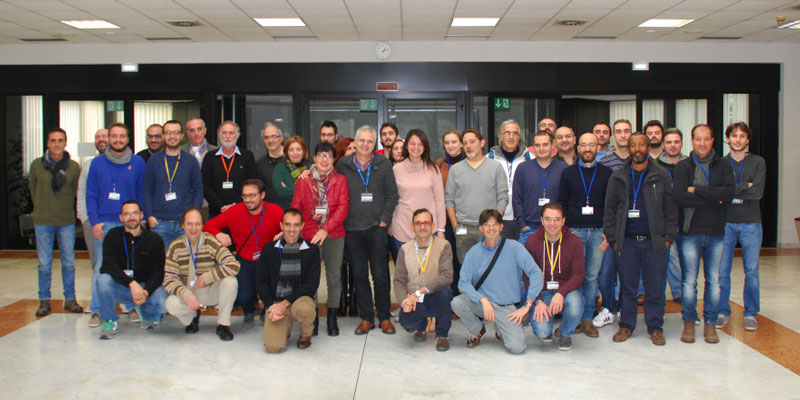by Erina Ferro, ISTI-CNR
The research area of the Italian National Research Council (CNR) in Pisa is a 130,000 m2 village where 3000 people live and move daily. It can thus be considered as a laboratory where smart solutions to problems that can be encountered in any town or city can be tested.
The Smart Badge registers someone’s presence when her or his own badge has been lost or forgotten, or is not usable as the person is temporarily working in another structure. The smart badge app, installed on a smart phone, offers three main functionalities: on-site check-in/check-out, remote registration, a list of recent entries/exits. In order to implement the remote check-in/check-out, the only hardware subsystem required is a GPS system, available on most smartphones: the user can see his own position and confirm the registration. For the local check-in/check-out, the app displays a dynamically generated QR-code with a user identifier, a code for the operation, and a unique one-time password that must match the corresponding password generated on the reader.
The main features of our low-cost Smart Parking application are: a multi-technology platform, interoperability, flexibility, utility, and low-bandwidth requirements for data transmission. Three monitoring technologies have ben integrated: four commercial ground sensors, installed in four parking lots and used as ground truth, nine newly developed embedded cameras, and nine newly developed smart cameras; each type of camera monitoring about 20 lots simultaneously. In both cameras, data are elaborated on board, and the binary information (empty/busy) regarding the monitored spaces is transmitted to the cloud dedicated to the smart area infrastructure. The smart cameras are constituted by a Raspberry Pi, equipped with a camera module; an algorithm has been developed that exploits some visual processing techniques to analyze the captured images, and a neural network trained using a deep learning approach to determine the occupancy status of the parking spaces.
The embedded cameras have a main board that manages both vision and networking tasks; other components are provided by the power supply system that manages charging and applies optimal energy savings policies. A dedicated vision logic has been designed and implemented.
The Smart Shared Mobility (SSM) allows users to share urban and suburban trips, customized wrt their preferences, requirements, and ride sharing habits. SSM includes a web application, accessible from the Smart Area web site, and the mobile app GoTogether. The solution provides highly personalized suggestions, both in response to explicit user requests, and proactively, selecting a set of most appropriate solutions based on the user’s history in the app usage and on reminder features. The solution is completely integrated with the Smart Area Cloud, through which it can access data of the other services (such as the smart parking) to provide additional features, and can also push its own data to the cloud, in order to enrich the entire system.
The Smart Building solution not only monitors the energy consumption of each single office, but also implements energy saving policies by recognising the presence of people in the room, and enables policies to detect and react to inappropriate intrusions in the monitored offices. To achieve these goals, a wireless sensor network (WSN) has been developed, where each node is equipped with many different types of transducers. The ZigBee technology is employed; each node of the WSN is connected to a Zigbee sink to which an IPv4 address is associated. Each in-building sensor is characterized by a physical location. The solution develops a pervasive infrastructure represented by the middleware used to build location-based services and is used to integrate different kinds of sensors thanks to its modular nature.
The Smart Navigation application (for smart phone and tablet) consists of an interactive, HTML5-based map of the CNR area in Pisa, and an indoor positioning service. The map is used to see the user’s own position within or without the buildings on the campus, to explore the floors of the buildings, to search for rooms or people, or to obtain directions to a specified destination. The interactive map is a web application consisting in a rich interactive map of the CNR campus, available to users with modern desktop or mobile browsers. No external proprietary services, such as Google Maps or similar, are used at runtime by the web application. The user indoor positioning facility constitutes a large research field; the solution we are implementing is based on Wi-Fi fingerprinting. The idea is to exploit the ability of the Wi-Fi receiver of a smartphone, carried by the user, to scan the existing Wi-Fi networks and, for each one, to measure the received signal strength (RSS) and to compare it with a database of measurements performed in known locations.
All data generated by the above mentioned applications converge in the Smart Area infrastructure, which is constituted by an OpenStack-based “Infrastructure as a Service” cloud architecture. In the cloud, meteorological data derived from the eight meteorological stations of CNR located throughout Italy is also collected.

The Smart Campus Group of the CNR Institutes in Pisa: ISTI, IIT and IFC.
Link: http://www.smart-applications.area.pi.cnr.it
Please contact:
Erina Ferro, ISTI-CNR, Italy











